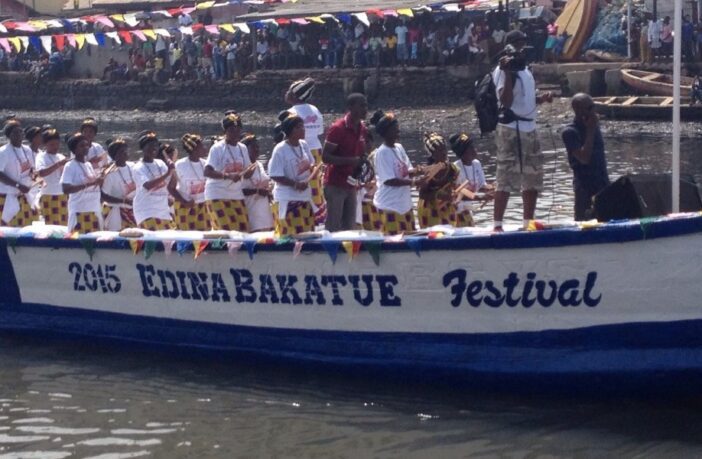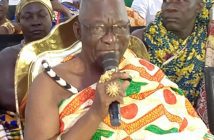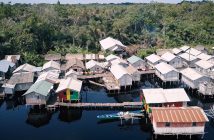The Bakatue Festival is a festival celebrated by the chiefs and peoples of Elmina in the Central Region of Ghana. The festival, which is said to have been established at least as far back as 1847, is celebrated on the first Tuesday in the month of July every year.
The festival is used to mark the beginning of the fishing season in Elmina. The name Bakatue is from the Fante dialect and translates as “draining of a lagoon”. The celebration of the festival was established to commemorate the founding of Elmina by the Portuguese in the early days of the colonization of the then Gold Coast. Bakatue is a festival of the people of Elmina township and its traditional area, a geographical stool land more appropriately referred to as “EDINAMAN”.
Origin Of Bakatue Festival
“Bakatue” translated means “the opening of the lagoon” or the “Draining of the Lagoon”. It is celebrated to commemorate the founding of the town, Elmina by the Europeans. It is also celebrated to invoke the deity, Nana Benya’s continuous protection of the state and its people.
The term “Bakatue” is contradictory in its literal meaning. This is because, the meaning, ‘opening up of the lagoon’, imdicates that, it needs to be dug and opened up by artificial means when constructed. But Benya on the other hand, naturally flows into the sea.
The lagoon is an arm of the sea and at high tide it runs four miles inland to “Anwiwdo” which is supposed to be the source of Benya. The term Bakatue therefore is only ironically applied and no Implements are necessary or employed to effect the opening into the sea as it is a tidal lagoon.
The founder, Kwa Amankwa is reported to have migrated from the Savana Based Walata Empire, settled at Techiman for some time, moved to Eguafo and thence to Elmina, where in search of drinking water and accidentally discovered a streamlet, exclaiming “Be-enya which expression means” I have found or got”.
To commemorate the discovery, a hut was erected where the emigrants refreshed. Kwa Amankwa bowed and worshipped and in the solemn silence there suddenly appeared before him a god animate of the Lagoon now called river Benya. The self-manifesting deity made human company with Amankwa for eight days, a period at the expiration of which a covenant was concluded between man and god.
The sayings of the covenant are:
1. That a Shrine was to be constructed by Amankwa in honour of Nana Benya which was to be the consecrated abode of the tutelary deity and from which Nana Benya would be invoked in times of need.
.2. That schedule was to be worked out from the phases of the moon which stipulated that the first Tuesday of the month of July of each calendar year shall be observed as a festival day in commemoration of this man-deity meeting.
3. That the Omanhen, Divisional Chiefs, Sub Chiefs, stool holders, Asafo elders Priests and Priestesses and the entire citizenry would present the sacred food (mixture of yam, palm oil and eggs) to the god of the River on the founder’s day.
PREPARATIONS TOWARDS THE FESTIVAL
The Bakatue Festival is celebrated for six weeks, each week filled with interesting cultural adventures.
WEEK 1: PURIFICATION OF WIDOWS AND CAPPING OF SHRINE
lt is customary for the citizenry to enter into a new era in ‘a state of purity. Consequently, tradition requires widow to cleanse themselves by terminating .widowhood during the period.
The willful neglect of this expensive obligation may force a defaulter to go into banishment, as non performance of the purification rite is sacrilegious. The Sacred _ Shrine has a detachable cap on top known in local parlance as “Burukutukyew”. It has mounted on it a white flag always facing easterly direction symbolising the glorious victory over the Fantes in the war of 1868.
The replacement of the cap is an annual affair and the old cap is carried to _ “Kunkuntar” to beswallowed by the sea. The new structure is woven on the ground and capped on top of the shrine at midnight hence the saying “Burukutukyew wo wen no ase ana wodze afow sor”.
WEEK 2: ABONFIRE AND “SOSOOGYA”
Bonfire, which is organised by the youth at the embankment of the river on Monday, is intended to drive away all ills of the dieting year. On the following day, the moral significance of the festival is reflected by the vulgarity of demonstration by men folk causing a lot of embarrassment to women of childbearing age. Hot spices stung on ingeniously contrived sticks are manipulated into the eyes, nose, mouth and ears of any woman met on the streets from midday to sunset. The young men do this as penance for wrongs and defilement blameable against women folk.
WEEK 3: RETALLIATION BY WOMEN AND WOOD PLATTER OVERTURN BY ANKOBEA SAFO (KORBABUTUW).
Tradition requires Ankobea Asafo (№.1) whose emblem is the key to go in an irregular procession to the Shrine on the evening of» Monday to perform a very important exclusive ceremony captioned the Overturn of the wooden platter (Korba Butuw), The journey of the militant company ends in front of the shrine where a sheep is presented to the state to be offered as sacrifice to the gods. The sacrificial ceremony symbolised the official proclamation of the strict observance of all taboos as already listed above. The Omanhen and his elders must witness the ceremony.
HOME COMING OF DEITY‘
On the midnight of the same Monday, four of the thirteen straw-hat bearers Who are state courtiers (Birifikyewfo) canoe to “Anwewdo”, the source of the river where they invoke and carry to the Shrine the spirit of the god Benya to guide and guard the state as they prepare to enter a new year. The sounding of the Royal State drum (Aketsewta) warns people to take cover and give way to the deity. The drum also plays a very important role in the invocation ceremony.
THE SACRIFICE
On the morning of the following day, Tuesday, the sheep presented by Ankobea Asafo is slaughtered and offered as sacrifice to the gods amidst libation and incantations.
VENGEANCE FROM WOMEN FOLK
On this day, Tuesday, the women organise retaliation and by using “Mpapan” to whip the men folk they meet. This signifies the condemnation of immorality on the side of men which is believed to be an offence against the state as a whole.
WEEK 4: FIRST “DOMB’O” DRUMMING
On the night of Monday of the 4th of the six-week period of preparation and ceremony, the first of three state drumming popularly called ”Dombo” comes on at the frontage of the sacred shrine. The traditional choristers (Apaafo) and drummers (Tentenfo) get ready to sing and beat the drums with Omanhen, Chiefs, and Stool holders. State Courtiers and all concerned citizens take their right positions and get themselves ready to watch the drumming and dancing and to consult the oracle and answer spiritual enquiries when necessary. At the appropriate time the 77 states gods descend simultaneously and, spiritually possessing the performing priest, direct and control his actions and utterances. In the olden days the sacred shrine itself danced to the rhythmical drumming.
WEEK 5: SECOND “DOMBO”
There is a repeat of the routine traditional drumming and dancing at the same place same time, same duration and same functionaries. Observers who missed the first Dombo take a turn at the second but generally no in habitant wants to miss any.
WEEK 6: “KORBATAE” MONDAY EVENING
It is now the turn and in fact the prerogative of AkyemfoAsafo (No.2) whose emblem is the Eagle (Korpon) to revoke the observance of taboos instituted by Ankobea ‘ Asafo in the third week of the preparatory period. On Monday evening (the eve of the festival), Akyemfo assemble in front of the Shrine to present a sheep as sacrificial offering in compliance with custom to signify the advent of the lifting of the ban impose six weeks previously. This ceremonial and ritualistic sacrifice which is’ captioned “KORBATAE” requires the active participation of the Omanhen his elders and the state courtiers.
MONDAY VIGIL
The penultimate climax of the festival is the all night drumming of Dombo where the high priests excel themselves in dancing to the style of their respective gods. The trained and experienced observer can tell which god is on the ascendancy by the dancing style of the priest on floor. This resounding of the third and final Dombo takes us to Tuesday morning the much-awaited day.
TUESDAY THE RED LETTER DAY
A royal procession made up of gorgeously dressed chiefs and stool holders, some of them riding in beautifully decorated palanquin. Fetish Priests and Priestesses, Herbalist, Supis, Asafohenfo and concerned citizens start from Akotobinsin at 12:00noon. The Paramount Chief of the traditional area appears last in the procession dressed in white cloth with “Nyinya Necklace“, He wears a straw hat (Birifikyew) and hold his sceptre all of which are symbolic of his high place and command. The attire sets him apart from all the other chiefs who wear gold ornaments.
The festival, with all its traditional glamour and spontaneous jubilation, end with a royal procession ending at the Omanhen’s Palace amidst instrumental and traditional drumming.
SOURCE: VISIT GHANA.COM





